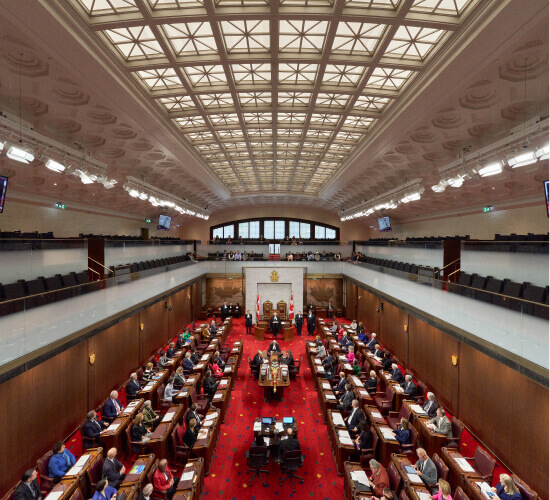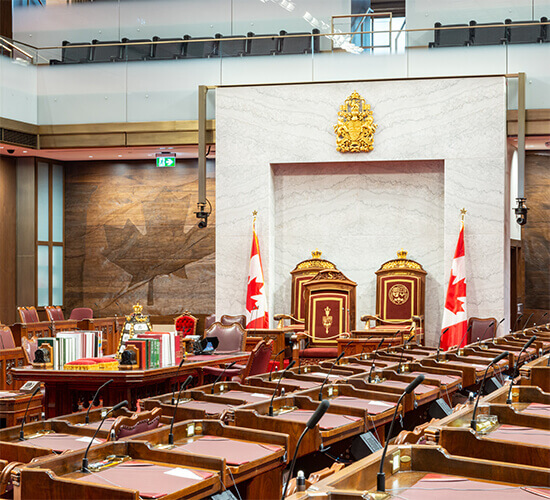Layout of the Chamber
The layout of the Senate Chamber is similar to the House of Lords in the United Kingdom because Canada’s Parliament is based on the British Westminster system. The Speaker of the Senate is seated at the head of the chamber and senators’ desks are on either side of the centre aisle. The layout of the interim chamber at the Senate of Canada Building is the same as the layout of the Senate Chamber in Centre Block, which is currently closed for rehabilitation.
Who’s Who in the Senate
Click on the numbers to see who works in the Senate

- 1 Speaker
- The Speaker of the Senate is in charge of managing debates in the Senate Chamber and maintaining order. The Speaker ensures that the rules, procedures and traditions of the Senate are followed. The thrones behind the Speaker’s Chair are used by the Monarch or Governor General and their consort (spouse or partner).
- 2 Senators
- Senators are appointed by the Governor General on the advice of the Prime Minister to represent Canada’s provinces and territories. The Senate’s 105 seats are distributed by region to ensure equal representation across the country. Senators are accomplished Canadians from various professional backgrounds. They introduce bills (proposed new laws), suggest amendments to legislation passed by the House of Commons, review public policy and debate issues.
- 3 Government Representative in the Senate
- The Government Representative in the Senate (formerly called the Government Leader in the Senate, a title sometimes still used) is a senator who is appointed by the Prime Minister to bring forward the government’s bills and policies in the Senate. This individual can attend Cabinet meetings and is responsible for answering questions about the government’s bills in the Senate Chamber.
- 4 Leader of the Opposition in the Senate
- The Leader of the Opposition in the Senate is a senator who is head of the largest party in the Senate not in government. It is up to the relevant party to determine how this individual is chosen. Part of the role of the Leader of the Opposition in the Senate is to challenge government bills being discussed in the Senate Chamber and committees.
- 5 Clerk of the Senate and Clerk of the Parliaments
- The roles of the Clerk of the Senate and the Clerk of the Parliaments are generally held by one person, who is the chief legislative services officer of the Senate. As Clerk of the Senate, this person advises the Speaker on procedural matters, supports the legislative process and has many duties related to the overall management of the Senate. As Clerk of the Parliaments, they are also the keeper of all original Acts (bills that have received Royal Assent) and are responsible for certifying true copies of these Acts.
- 6 Usher of the Black Rod
- The Usher of the Black Rod has many ceremonial and administrative duties, including leading the Speaker’s Parade to start the day and overseeing the security of the chamber. The Usher of the Black Rod coordinates the Speech from the Throne as well as the Royal Assent ceremony, in which the Governor General signifies assent by a nod of the head, making a bill an Act of Parliament and part of the law of Canada. The Black Rod is an ebony cane used to knock on the House of Commons doors to request access to the chamber.
- 7 Table Officers
- Table officers are clerks who advise the Speaker and other senators on procedural matters. They also record proceedings and decisions in the official record of the Senate, called the Journals of the Senate. They sit at the Clerk’s Table in the chamber.
- 8 Stenographers
- Stenographers produce the transcript of the debates, discussions and decisions in the Senate. This transcript, commonly known as Hansard, is published in English and French after each sitting day.
- 9 Pages
- Pages are university students from across Canada who are hired to support and assist the senators in the chamber and in committee meetings.
- 10 Mace
- The Mace is the symbol of the Senate’s authority, and the Senate cannot meet unless it is in the chamber. The Mace is carried during the Speaker’s Parade and placed on the Clerk’s Table, pointing toward the Thrones. Once the Mace is laid on the table, the Senate is officially in session.
Selected People in the Senate Chamber
- The Speaker of the Senate is in charge of managing debates in the Senate Chamber and maintaining order. The Speaker ensures that the rules, procedures and traditions of the Senate are followed. The Speaker also has duties outside the chamber, such as receiving diplomats and foreign dignitaries and representing the Senate of Canada abroad. Senators represent the people of their home region, and as a senator, the Speaker does too.
- Senators are appointed by the Governor General on the advice of the Prime Minister to represent Canada’s provinces and territories. The Senate’s 105 seats are distributed by region to ensure representation across the country. Senators are accomplished Canadians from various professional backgrounds. They introduce bills (proposed new laws), suggest amendments to legislation passed by the House of Commons, review public policy and debate issues.
- The Government Representative in the Senate (formerly called the Government Leader in the Senate, a title sometimes still used) is a senator who is appointed by the Prime Minister to bring forward the government’s bills and policies in the Senate. This individual can attend Cabinet meetings and is responsible for answering questions about the government’s bills in the Senate Chamber.
- The Leader of the Opposition in the Senate is a senator who is head of the largest party in the Senate not in government. It is up to the relevant party to determine how this individual is chosen. Part of the role of the Leader of the Opposition in the Senate is to challenge government bills being discussed in the Senate Chamber and committees.
- The roles of the Clerk of the Senate and the Clerk of the Parliaments are generally held by one person, who is the chief legislative services officer of the Senate. As Clerk of the Senate, this person advises the Speaker on procedural matters, supports the legislative process and has many duties related to the overall management of the Senate. As Clerk of the Parliaments, they are also the keeper of all original Acts (bills that have received Royal Assent) and are responsible for certifying true copies of these Acts.
- The Usher of the Black Rod has many ceremonial and administrative duties, including leading the Speaker’s Parade to start the day and overseeing the security of the chamber. The Usher of the Black Rod coordinates the Speech from the Throne as well as the Royal Assent ceremony, in which the Governor General signifies assent by a nod of the head, making a bill an Act of Parliament and part of the law of Canada. The Black Rod is an ebony cane used to knock on the House of Commons doors to request access to the chamber.
- Table officers are clerks who advise the Speaker and other senators on procedural matters. They also record proceedings and decisions in the official record of the Senate called the Journals of the Senate. They sit at the Clerk’s Table in the chamber.
- Stenographers produce the transcript of the debates, discussions and decisions in the Senate. This transcript, commonly known as Hansard, is published in English and French after each sitting day.
- Pages are university students from across Canada who are hired to support and assist senators in the chamber and in committee meetings.


Symbols and Objects in the Chamber
- The Thrones behind the Speaker’s Chair are used by the Monarch or Governor General and their consort (spouse or partner). These thrones and the Speaker’s Chair were made to celebrate the 150th anniversary of Confederation. They feature the Coat of Arms of Canada and symbols of royalty and New France.
- The Speaker’s Chair is the seat of the Speaker of the Senate. The Speaker oversees chamber business while seated in this chair. When the Monarch or their representative is present, the Speaker’s Chair is removed.
- The Mace is the symbol of the Senate’s authority and the Senate cannot meet unless it is in the chamber. The Mace is carried during the Speaker’s Parade and placed on the Clerk’s Table, pointing toward the Thrones. Once the Mace is laid on the table, the Senate is officially in session.
- The Senate is often referred to as the Red Chamber because the carpet and the chairs are red, a traditional colour of royalty. This is one way in which Canada’s Senate is like the House of Lords in the U.K. Parliament, whose members sit on red benches.
- The Bar of the Senate is the brass railing at the entrance to the chamber. Traditionally, members of the House of Commons, except for the Prime Minister when invited, must stay behind the brass bar. This symbolizes the independence of the Senate from the House of Commons.
